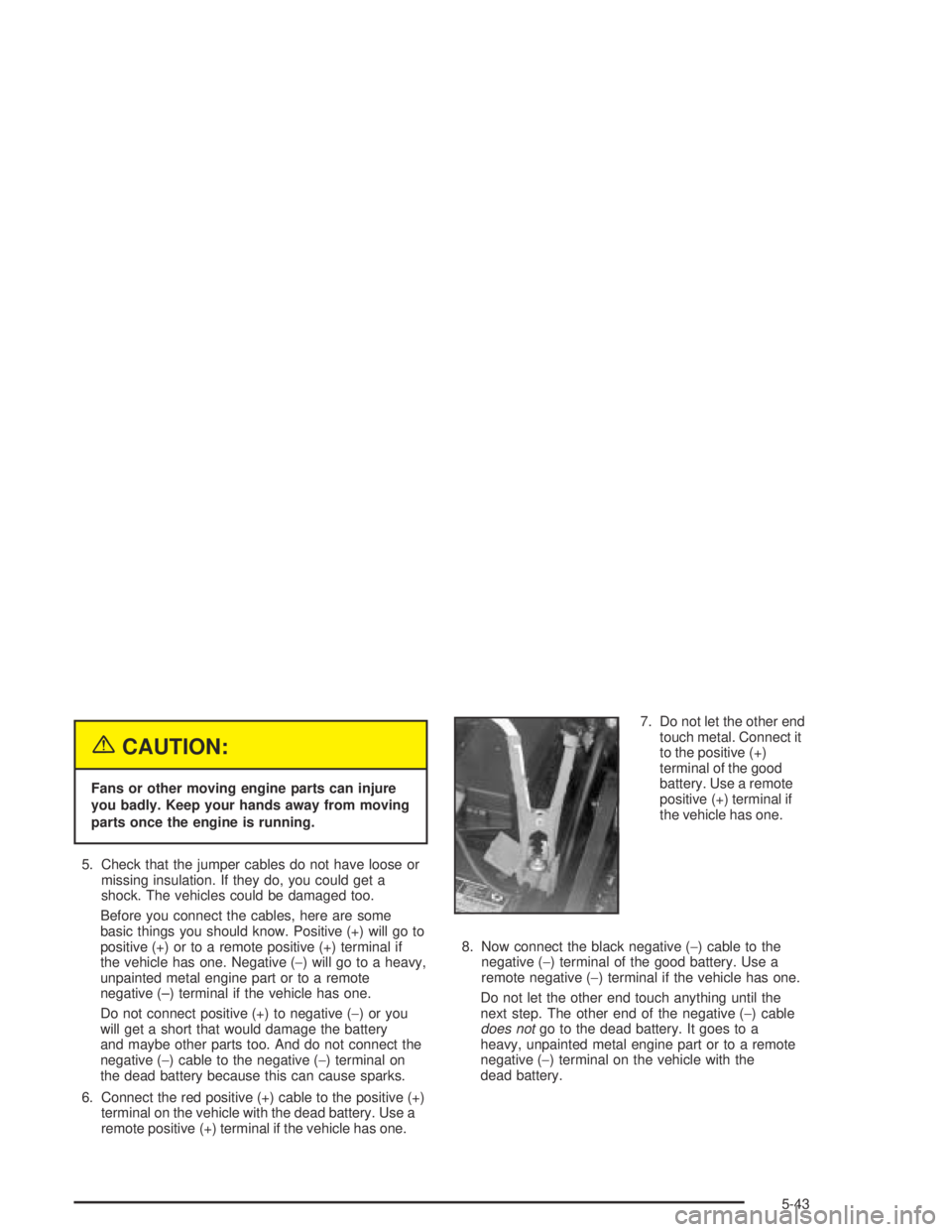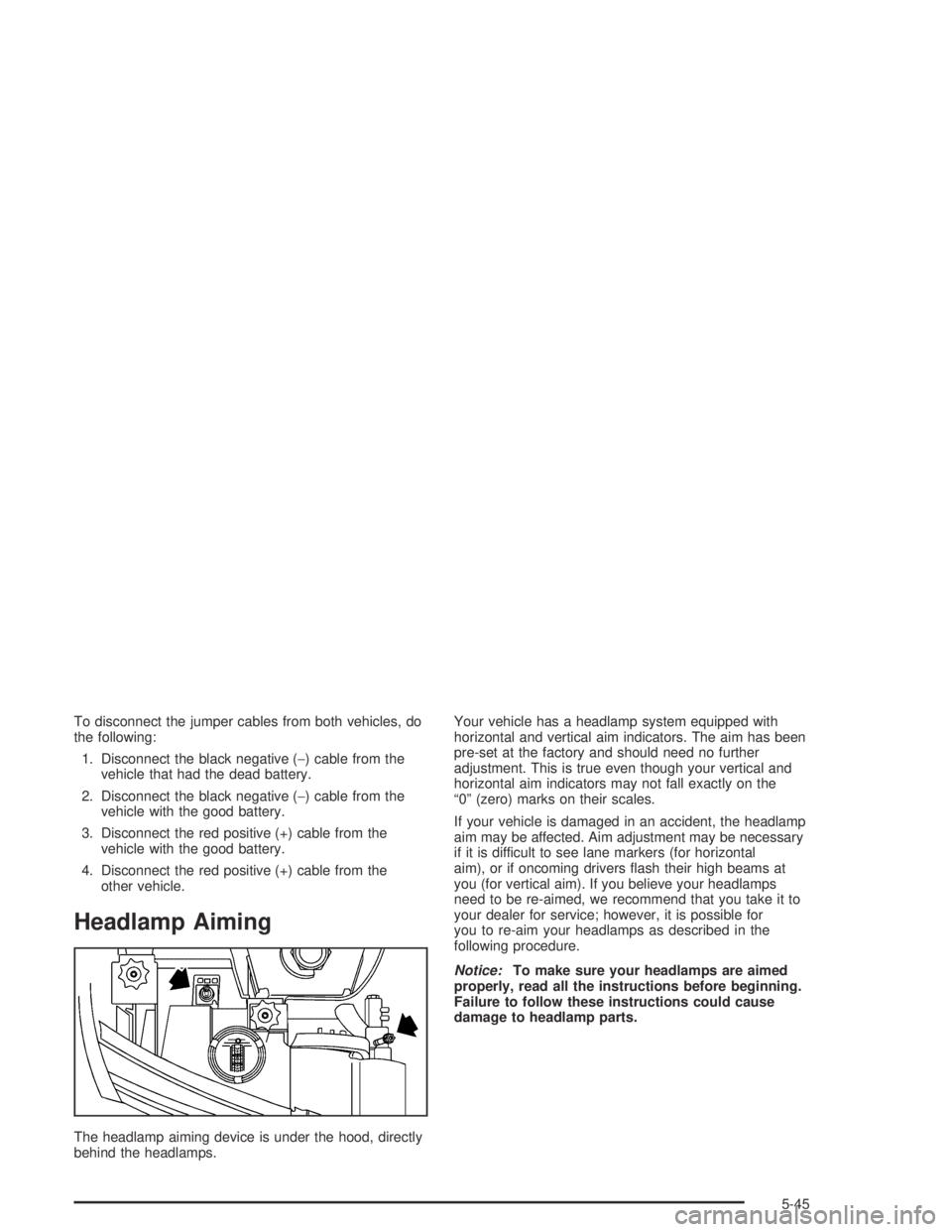2005 BUICK PARK AVENUE battery
[x] Cancel search: batteryPage 275 of 388

{CAUTION:
Fans or other moving engine parts can injure
you badly. Keep your hands away from moving
parts once the engine is running.
5. Check that the jumper cables do not have loose or
missing insulation. If they do, you could get a
shock. The vehicles could be damaged too.
Before you connect the cables, here are some
basic things you should know. Positive (+) will go to
positive (+) or to a remote positive (+) terminal if
the vehicle has one. Negative (−) will go to a heavy,
unpainted metal engine part or to a remote
negative (–) terminal if the vehicle has one.
Do not connect positive (+) to negative (−)oryou
will get a short that would damage the battery
and maybe other parts too. And do not connect the
negative (−) cable to the negative (−) terminal on
the dead battery because this can cause sparks.
6. Connect the red positive (+) cable to the positive (+)
terminal on the vehicle with the dead battery. Use a
remote positive (+) terminal if the vehicle has one.7. Do not let the other end
touch metal. Connect it
to the positive (+)
terminal of the good
battery. Use a remote
positive (+) terminal if
the vehicle has one.
8. Now connect the black negative (−) cable to the
negative (−) terminal of the good battery. Use a
remote negative (−) terminal if the vehicle has one.
Do not let the other end touch anything until the
next step. The other end of the negative (−) cable
does notgo to the dead battery. It goes to a
heavy, unpainted metal engine part or to a remote
negative (−) terminal on the vehicle with the
dead battery.
5-43
Page 276 of 388

9. Connect the other end of the negative (−) cable at
least 18 inches (45 cm) away from the dead battery,
but not near engine parts that move. The electrical
connection is just as good there, and the chance
of sparks getting back to the battery is much less.
10. Now start the vehicle with the good battery and run
the engine for a while.
11. Try to start the vehicle that had the dead battery.
If it will not start after a few tries, it probably
needs service.
Notice:If the jumper cables are removed in the
wrong order, electrical shorting may occur and
damage the vehicle. The repairs would not be
covered by your warranty. Remove the jumper
cables in the correct order, making sure that the
cables do not touch each other or other metal.
A. Heavy, Unpainted Metal Engine Part or Remote
Negative (−) Terminal
B. Good Battery or Remote Positive (+) or Remote
Negative (−) Terminals
C. Dead Battery or Remote Positive (+) TerminalJumper Cable Removal
5-44
Page 277 of 388

To disconnect the jumper cables from both vehicles, do
the following:
1. Disconnect the black negative (−) cable from the
vehicle that had the dead battery.
2. Disconnect the black negative (−) cable from the
vehicle with the good battery.
3. Disconnect the red positive (+) cable from the
vehicle with the good battery.
4. Disconnect the red positive (+) cable from the
other vehicle.
Headlamp Aiming
The headlamp aiming device is under the hood, directly
behind the headlamps.Your vehicle has a headlamp system equipped with
horizontal and vertical aim indicators. The aim has been
pre-set at the factory and should need no further
adjustment. This is true even though your vertical and
horizontal aim indicators may not fall exactly on the
“0” (zero) marks on their scales.
If your vehicle is damaged in an accident, the headlamp
aim may be affected. Aim adjustment may be necessary
if it is difficult to see lane markers (for horizontal
aim), or if oncoming drivers �ash their high beams at
you (for vertical aim). If you believe your headlamps
need to be re-aimed, we recommend that you take it to
your dealer for service; however, it is possible for
you to re-aim your headlamps as described in the
following procedure.
Notice:To make sure your headlamps are aimed
properly, read all the instructions before beginning.
Failure to follow these instructions could cause
damage to headlamp parts.
5-45
Page 368 of 388

Roadside Assistance Program
Call 1-800-252-1112 for Buick Roadside Assistance.
As the proud owner of a new Buick vehicle, you
are automatically enrolled in the Buick Roadside
Assistance program. This value-added service is
intended to provide you with peace of mind as you drive
in the city or travel the open road. Buick’s Roadside
Assistance toll-free number is staffed by courteous and
capable Roadside Assistance Representatives who
are available 24 hours a day, 365 days a year.
We will provide the following services during the
Bumper-to-Bumper warranty period, at no expense
to you:
Fuel Delivery:Delivery of enough fuel,
$5 maximum, for the customer to get to the nearest
service station.
Lock-out Service (identi�cation required):
Replacement keys or locksmith service will
be covered at no charge if you are unable to gain
entry into your vehicle. Delivery of the replacement
key will be covered within 10 miles.
Emergency Tow:Tow to the nearest dealership for
warranty service or in the event of a
vehicle-disabling accident. Assistance when the
vehicle is mired in sand, mud, or snow.
Flat Tire Change:Installation of a spare tire will be
covered at no charge. The customer is responsible
for the repair or replacement of the tire if not
covered by a warrantable failure.
Jump Start:No-start occurrences which require a
battery jump start will be covered at no charge.
Dealer Locator Service
In many instances, mechanical failures are covered
under Buick’s Bumper-to-Bumper warranty. However,
when other services are utilized, our Roadside
Assistance Representatives will explain any payment
obligations you might incur.
For prompt and efficient assistance when calling,
please provide the following to the Roadside
Assistance Representative:
Your name, home address, and home
telephone number.
Telephone number of your location.
Location of the vehicle.
Model, year, color, and license plate number.
Mileage, Vehicle Identi�cation Number, and delivery
date of the vehicle.
Description of the problem.
7-6
Page 376 of 388

Audio System(s) (cont.)
Trunk-Mounted CD Changer..........................3-66
Understanding Radio Reception.....................3-72
Automatic Transaxle
Fluid..........................................................5-22
Operation...................................................2-26
B
Battery..........................................................5-40
Run-Down Protection...................................3-19
Battery Warning Light......................................3-37
Before Leaving on a Long Trip.........................4-22
Brake
Anti-Lock Brake System (ABS)........................ 4-7
Emergencies................................................ 4-9
Parking......................................................2-29
System Inspection.......................................6-24
System Warning Light..................................3-38
Brakes..........................................................5-37
Braking........................................................... 4-6
Braking in Emergencies..................................... 4-9
Break-In, New Vehicle.....................................2-22
Bulb Replacement...........................................5-47
Front Turn Signal Lamps..............................5-50
Halogen Bulbs............................................5-47
Headlamp Aiming........................................5-45
Headlamps.................................................5-47Bulb Replacement (cont.)
Rear Quarter Panel Turn Signal and
Stoplamps...............................................5-54
Rear Turn Signal, Stoplamps and
Back-Up Lamps.......................................5-50
Replacement Bulbs......................................5-56
Buying New Tires...........................................5-68C
California Fuel.................................................. 5-5
Canadian Owners................................................ ii
Capacities and Speci�cations..........................5-100
Carbon Monoxide...................2-14, 2-32, 4-25, 4-37
Care of
Safety Belts................................................5-86
Your Cassette Tape Player............................3-73
Your CD Player...........................................3-74
Your CDs ...................................................3-74
CD Changer, Trunk-Mounted............................3-66
Center Console Storage Area...........................2-46
Center Passenger Position, Safety Belts.............1-19
Chains, Tire...................................................5-72
Check
Engine Light...............................................3-40
Tire Pressure System...................................5-65
Checking Things Under the Hood......................5-10
Chemical Paint Spotting...................................5-89
2
Page 379 of 388

E
Electrical System
Add-On Equipment......................................5-91
Auxiliary Instrument Panel Fuse Block............5-94
Fuses and Circuit Breakers...........................5-92
Main Instrument Panel Fuse Block.................5-92
Rear Compartment Fuse Block......................5-97
Underhood Fuse Block.................................5-95
Engine
Air Cleaner/Filter.........................................5-19
Battery.......................................................5-40
Check and Service Engine Soon Light............3-40
Coolant......................................................5-24
Coolant Heater............................................2-25
Coolant Temperature Gage...........................3-40
Cooling System Inspection............................6-24
Drive Belt Routing......................................5-102
Engine Compartment Overview......................5-12
Exhaust.....................................................2-32
Oil .............................................................5-13
Overheating................................................5-26
Starting......................................................2-24
Supercharger Oil.........................................5-18
Entry Lighting.................................................3-16
Event Data Recorders (EDR)............................. 7-9
Extender, Safety Belt.......................................1-26
Exterior Lamps...............................................3-14
F
Filter
Engine Air Cleaner......................................5-19
Finish Damage...............................................5-89
Flash-to-Pass................................................... 3-9
Flat Tire........................................................5-73
Flat Tire, Changing.........................................5-74
Flat Tire, Storing.............................................5-80
Fluid
Automatic Transaxle.....................................5-22
Power Steering...........................................5-34
Windshield Washer......................................5-35
Front Reading Lamps......................................3-18
Fuel............................................................... 5-4
Additives...................................................... 5-5
California Fuel.............................................. 5-5
Filling a Portable Fuel Container..................... 5-9
Filling Your Tank........................................... 5-6
Fuels in Foreign Countries.............................. 5-6
Gage.........................................................3-45
Gasoline Octane........................................... 5-4
Gasoline Speci�cations.................................. 5-5
System Inspection.......................................6-23
5
Page 381 of 388

I
If You Are Stuck in Sand, Mud, Ice or Snow.......4-29
Ignition Positions.............................................2-22
Infants and Young Children, Restraints...............1-29
In�ation -- Tire Pressure..................................5-64
Inspection
Brake System.............................................6-24
Engine Cooling System................................6-24
Exhaust System..........................................6-23
Fuel System...............................................6-23
Part C - Periodic Maintenance.......................6-23
Steering, Suspension and Front Drive Axle
Boot and Seal.........................................6-23
Throttle System...........................................6-24
Instrument Panel
Brightness..................................................3-16
Cluster.......................................................3-33
Overview..................................................... 3-4
J
Jump Starting.................................................5-41
K
Keyless Entry System....................................... 2-5
Keys............................................................... 2-3
L
Labelling, Tire Sidewall....................................5-59
Lamps
Battery Run-Down Protection.........................3-19
Cornering...................................................3-15
Courtesy....................................................3-16
Exterior......................................................3-14
Front Reading.............................................3-18
Glove Box..................................................3-18
Rear Reading.............................................3-19
Trunk.........................................................3-19
Twilight Sentinel
®........................................3-16
LATCH System
Child Restraints...........................................1-40
Securing a Child Restraint Designed
for the LATCH System..............................1-42
Leaving Your Vehicle.......................................2-13
Light
Airbag Readiness........................................3-36
Anti-Lock Brake System Warning...................3-39
Battery Warning..........................................3-37
Brake System Warning.................................3-38
Cruise Control.............................................3-44
Malfunction Indicator....................................3-40
Oil Pressure...............................................3-43
Safety Belt Reminder...................................3-36
Security.....................................................3-44
7